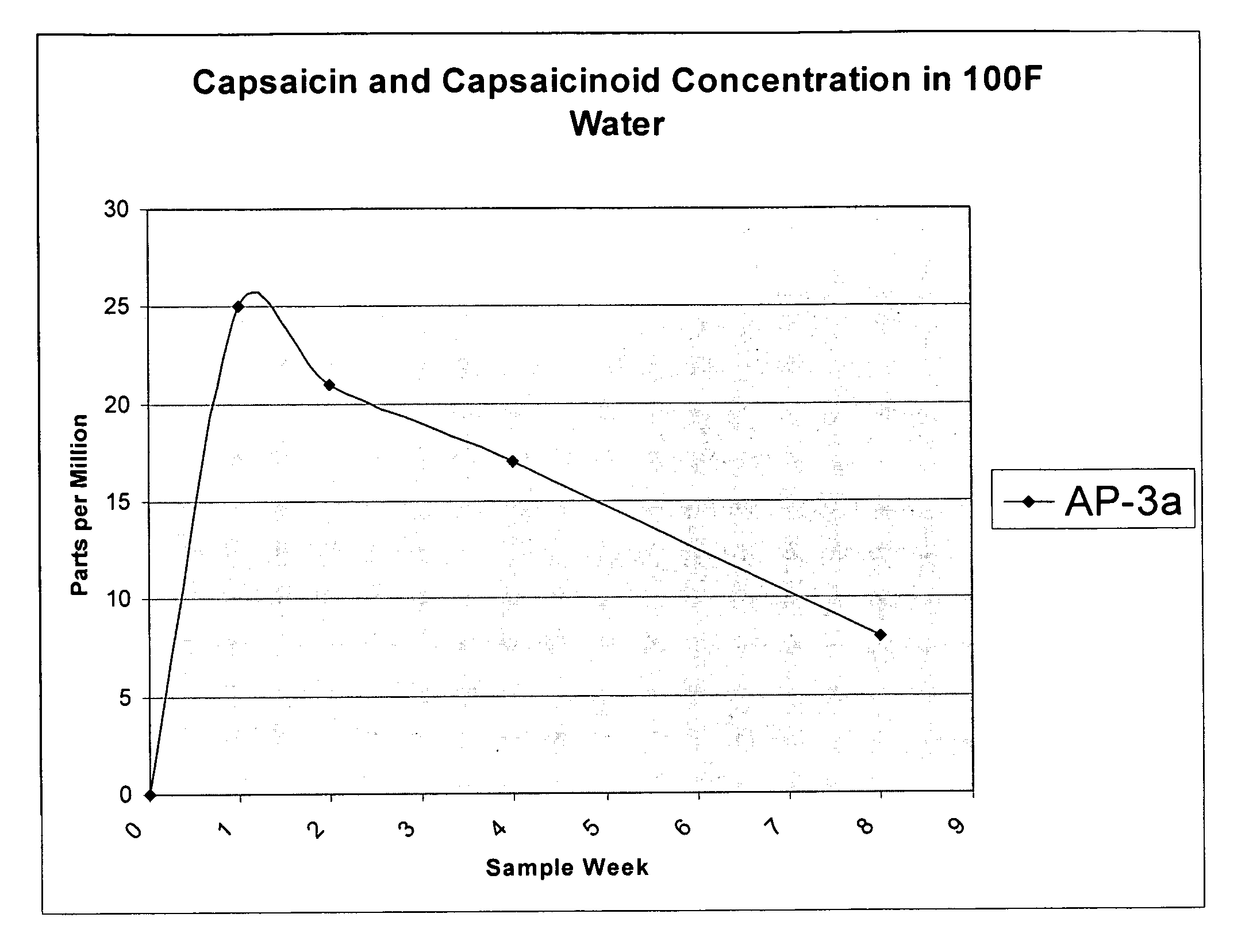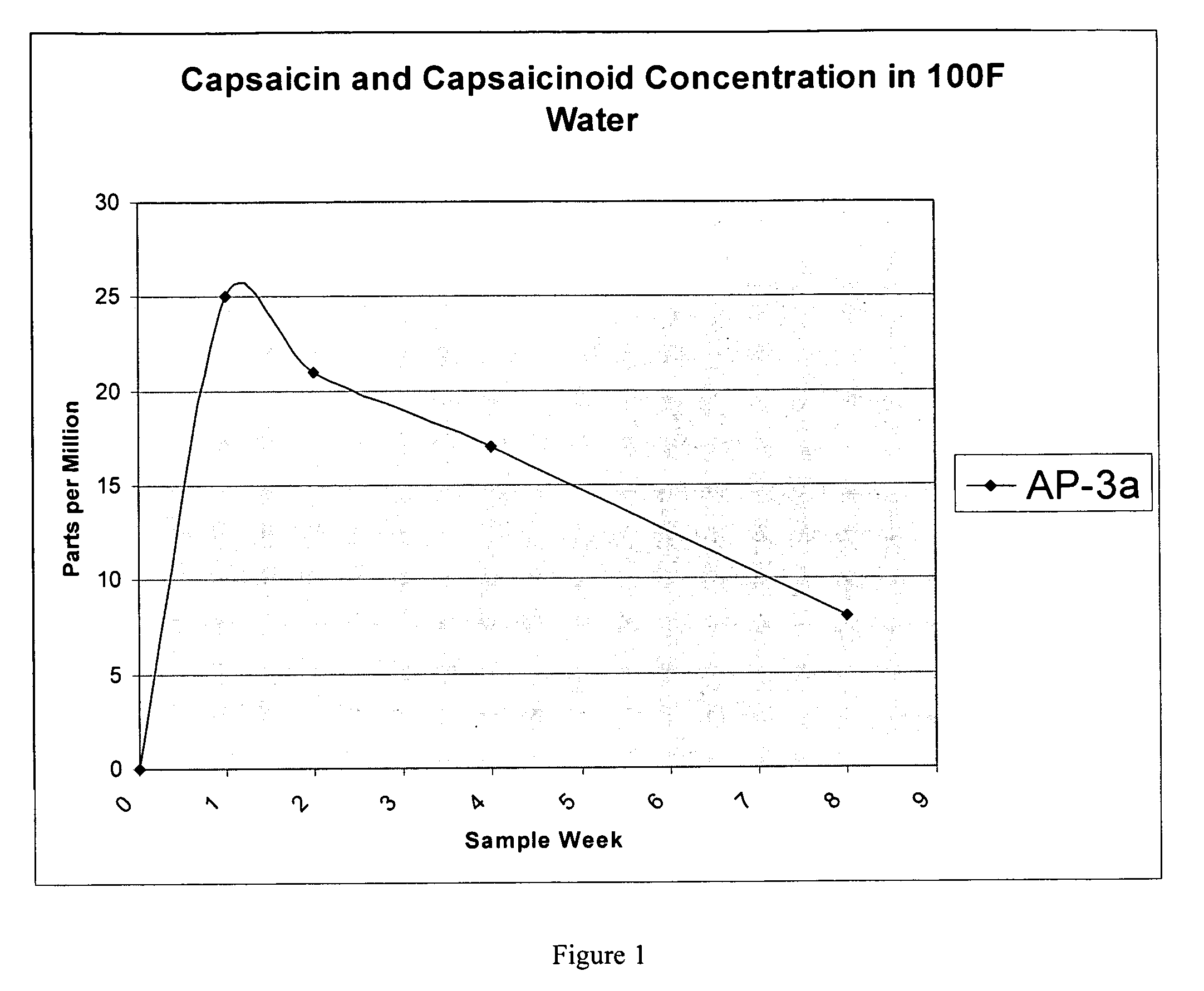Long lasting natural anti-pest additive
a technology of additives and natural anti-pest, applied in the field of long-lasting natural anti-pest additives, can solve problems such as incompatibility
- Summary
- Abstract
- Description
- Claims
- Application Information
AI Technical Summary
Benefits of technology
Problems solved by technology
Method used
Image
Examples
example 1
Retention Through Processing
[0051] A repellent with a 1 million Scoville Heat Unit (SHU) rating was employed. The SHU is a measure of the capsaicinoid content of pepper extract (16 million SHU=100% capsaicinoid). The functional inert materials consisted of ceramic beads, activated carbon, and a paint pigment. Different ratios of repellent-to-functional inert material were employed in each case. The additives then were incorporated into samples of various types of products employing commercial extrusion and compression molding processes.
[0052] Polyethylene polymer matrices, which are representative of the most difficult types of products into which to incorporate the additives such that the potency of the repellents remains at effective levels in the products during the manufacture of the products and subsequently for extended periods of time during the commercial use of the products, were employed in most cases.
[0053] Similarly, extrusion processes, which subject the materials to...
example 2
[0058] Anti-Pest Aging Study Results in Parts Per Million of Capsaicin
FormulaPelletMaterialDescriptionlevelanalysisStartWeek 1Week 2Week 4Week 8AP-3AInjected10,40013,00002521178extract1.04%1.30%00.0025%0.0021%0.0017%0.0008%
[0059]FIG. 1 is a chart showing the results of an accelerated aging test. Amounts of capsaicin lost to the water medium is shown by week for the test additive and is indicated in the table above. The AP-3a formulation included 1.04% capsaicin by weight (10,400 parts per million) in a polyethylene carrier as a concentrated additive in pellet form. The pellets were analyzed after production by liquid chromatograph and the amount of capsaicin was confirmed. Sample pellets were then placed in sealed ampules of water and maintained at a temperature of 100 degrees Fahrenheit for the time period indicated. The capsaicin content of the water was analyzed by liquid chromatograph at intervals and reported in parts per million. At a conservative release r...
example 3
Protection from Rodent Damage to Thin Polyethylene (PE) Extrusions
Target
Screening tests: The effect of capsaicin on rodent repellency of treated PE extrusions.
Materials
[0061] 1. Externally treated product—0.2 mm thickness. [0062] 1.1 Control—Thin extrusions made of HDPE black compound [0063] 1.2 Treated—Extrusions were coated with capsaicin solution. An oily extract containing 5% capsaicin was diluted in Hexane in ratio 1:4 (20%). Note: This experiment did not use the additives of the invention.
[0064] 2. Product with additive of the invention
[0065] This extrusions—0.2 mm thickness, were prepared on a laboratory extruder: [0066] 2.1 Control—100% Black HDPE compound [0067] 2.2 90% black HDPE compound+10% AP 4 (Master-batch containing 0.63% capsaicin and providing 0.063% capsaicin in the extruded sample) [0068] 2.3 85% black HDPE+15% AP4 (Master-batch containing 0.63% capsaicin and providing 0.095% capsaicin in the extruded sample) [0069] 2.4 90% black HDPE+10% AP3 (Master-bat...
PUM
| Property | Measurement | Unit |
|---|---|---|
| diameter | aaaaa | aaaaa |
| diameter | aaaaa | aaaaa |
| diameter | aaaaa | aaaaa |
Abstract
Description
Claims
Application Information
 Login to View More
Login to View More - R&D
- Intellectual Property
- Life Sciences
- Materials
- Tech Scout
- Unparalleled Data Quality
- Higher Quality Content
- 60% Fewer Hallucinations
Browse by: Latest US Patents, China's latest patents, Technical Efficacy Thesaurus, Application Domain, Technology Topic, Popular Technical Reports.
© 2025 PatSnap. All rights reserved.Legal|Privacy policy|Modern Slavery Act Transparency Statement|Sitemap|About US| Contact US: help@patsnap.com


